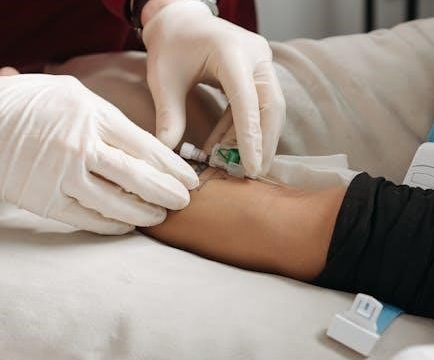Bates’ Guide to Physical Examination and History Taking: A Comprehensive Overview
Bates’ Guide offers step-by-step guidance on patient interviews and examinations. It emphasizes clinical reasoning, shared decision-making, and core assessment skills. Based on clinical evidence, it’s designed for health profession students.
Bates’ Guide to Physical Examination and History Taking is a foundational resource designed for students and practitioners in the healthcare field. It serves as a comprehensive textbook, providing step-by-step guidance on conducting patient interviews and performing thorough physical examinations. The guide emphasizes the importance of gathering a sensitive and nuanced patient history, as well as mastering the techniques of physical assessment.
The book helps clinicians to build strong patient relationships. Bates’ Guide is available in various formats, including PDF and print, with different editions catering to diverse learning preferences. The text also promotes clinical reasoning skills.
With over 8 hours of video content, Bates enhances the learning experience through visual demonstrations.
Core Concepts in Physical Examination
Bates’ Guide highlights core concepts in examinations. Emphasizing thoroughness and accuracy, it covers essential techniques for assessing patients. The guide deepens patient relationships, focusing assessment and directing clinical thinking.
The Patient Interview
The patient interview, as detailed in Bates’ Guide, is a cornerstone of effective healthcare. It describes how to take the health history, and it emphasizes sensitive communication. Your ability to gather a nuanced history focuses your assessment, and it sets the direction of your clinical thinking. Bates’ Guide provides authoritative guidance to learn to talk with patients, to perform the patient interview.
The comprehensive history includes Identifying Data and Source of the History, Chief Complaint(s), Present Illness, Past History, Family History, Personal and Social History, and Review of Systems. The patient interview is a vital component of the comprehensive history, allowing you to gather information.
It reminds students of common, normal, and abnormal findings.
Techniques of Physical Examination
Bates’ Guide provides an illustrated review of the physical examination. The techniques of physical examination are time-honored skills. Your ability to perform a thorough and accurate examination deepens your patient relationships. It also focuses your patient assessment.
It provides step-by-step guidance on performing the physical examination, and it reminds students of common and abnormal physical findings. Bates’ Guide also describes special techniques of assessment.
The techniques of physical examination that you are about to learn embody time-honored skills of healing and patient care. Your ability to gather a sensitive and nuanced history and to perform a thorough and accurate examination deepens your patient relationships.

Key Components of History Taking
The comprehensive history includes identifying data, the source, and the chief complaints. It also dives into the present illness, past history, family history, and personal and social history.
Chief Complaint and Present Illness
The chief complaint represents the patient’s primary reason for seeking medical attention, articulated in their own words. It’s crucial to record this verbatim, providing a clear starting point for the clinical encounter. Following the chief complaint, the present illness (HPI) elaborates on this concern, detailing its onset, duration, character, and associated symptoms.
A thorough exploration of the HPI involves employing various techniques to gather comprehensive information. This includes utilizing the seven attributes of a symptom: location, quality, quantity or severity, timing, setting in which it occurs, factors that aggravate or relieve it, and associated manifestations. Gathering this information helps paint a vivid picture of the patient’s experience.
Furthermore, it’s essential to consider pertinent positives and negatives, relevant medications, allergies, and any self-treatment measures the patient has undertaken. This detailed account forms the foundation for accurate diagnosis and effective treatment planning, ensuring patient-centered care.
Past Medical History
The past medical history is a comprehensive review of the patient’s previous health status, encompassing a wide range of information. This section includes details about prior illnesses, both acute and chronic, providing insights into potential underlying conditions or predispositions. Surgical history is documented, including dates and types of procedures, which may influence current health concerns.
A complete medication list, including names, dosages, frequencies, and routes of administration, is crucial for identifying potential drug interactions or side effects. Allergies to medications, food, or environmental factors are carefully noted to prevent adverse reactions. Immunization records are reviewed to assess the patient’s protection against preventable diseases.
Furthermore, it’s important to inquire about past hospitalizations, serious injuries, and any significant medical events. This detailed exploration of the past medical history provides a valuable context for understanding the patient’s overall health trajectory and informing present clinical decisions.
Family History and Social History
The family history explores the health of the patient’s close relatives, including parents, siblings, and children. This section aims to identify any genetic predispositions or familial patterns of disease. Specific attention is given to conditions such as heart disease, cancer, diabetes, and mental health disorders, as these may increase the patient’s risk.
The social history delves into the patient’s lifestyle and environment, encompassing factors that significantly impact health. This includes information about their occupation, education, and living situation. Habits such as smoking, alcohol consumption, and drug use are carefully assessed, along with dietary patterns and exercise routines.
Relationship status, social support systems, and exposure to environmental hazards are also considered. Cultural and spiritual beliefs may influence healthcare decisions. Gathering a thorough family and social history provides a holistic understanding of the patient’s health within their broader context.

Utilizing Bates’ Guide in Clinical Practice
Bates’ Guide facilitates effective patient interviews and physical exams. Its focus is on clinical reasoning and shared decision-making. This is based on clinical evidence. It aids in core assessment skill development for students.
Application of Clinical Reasoning
Bates’ Guide emphasizes integrating clinical reasoning into every aspect of patient assessment; This involves synthesizing information gathered from the patient’s history and physical examination to formulate a differential diagnosis. The guide encourages a systematic approach to problem-solving, helping clinicians prioritize potential diagnoses based on prevalence, severity, and treatability.
It provides frameworks for analyzing clinical data, identifying patterns, and generating hypotheses. The application of clinical reasoning is further enhanced through case studies and examples that illustrate how experienced clinicians approach complex diagnostic challenges. Bates’ Guide also stresses the importance of continuous learning and self-reflection in refining one’s clinical reasoning skills.
By mastering the principles outlined in Bates’ Guide, clinicians can improve their diagnostic accuracy and provide more effective patient care. Ultimately, the guide empowers healthcare professionals to make well-informed decisions that are tailored to each patient’s unique circumstances.
Shared Decision-Making
Bates’ Guide champions shared decision-making, recognizing patients as active partners in their healthcare. This approach involves a collaborative dialogue where clinicians share their expertise and patients contribute their values, preferences, and goals.
The guide provides practical strategies for engaging patients in meaningful conversations, ensuring they understand their options, including potential benefits and risks. Effective communication techniques, such as active listening and clear explanations, are emphasized to foster trust and rapport. Bates’ Guide also addresses challenges in shared decision-making, such as patients with limited health literacy or conflicting beliefs.
By embracing shared decision-making, clinicians can empower patients to make informed choices that align with their individual needs and circumstances. This patient-centered approach promotes greater satisfaction, adherence to treatment plans, and ultimately, improved health outcomes. The guide underscores the ethical imperative of respecting patient autonomy and promoting their well-being through shared decision-making.

Resources and Editions
Bates’ Guide is available in various formats, including PDF and print. Different editions cater to evolving medical knowledge. Explore resources that offer comprehensive guidance on performing patient interviews, physical examinations, clinical reasoning, and shared decision-making practices.
Available Formats: PDF and Print
Bates’ Guide to Physical Examination and History Taking caters to diverse learning preferences through its availability in both PDF and print formats. The PDF version offers portability and accessibility on various devices, facilitating convenient study and reference. Students and practitioners can easily search for specific topics, bookmark important sections, and carry the entire guide on laptops, tablets, or smartphones.
The print version provides a traditional learning experience with the tactile feel of a physical book. Many appreciate the ability to annotate pages, easily flip between sections, and have a tangible resource for quick reference in clinical settings. Choosing between PDF and print depends on individual study habits, technological preferences, and the specific demands of their learning or practice environment. Both formats ensure access to the guide’s comprehensive content, supporting effective learning and application of physical examination and history-taking techniques.
Exploring Different Editions
Bates’ Guide to Physical Examination and History Taking has evolved through numerous editions, each reflecting advancements in medical knowledge and clinical practice. Exploring these different editions offers valuable insights into the historical context and progression of physical examination techniques. Earlier editions may provide foundational knowledge and classic approaches, while later editions incorporate updated guidelines, diagnostic criteria, and technological innovations.
Students and practitioners can benefit from comparing editions to understand how specific examination methods have been refined or replaced over time. Examining older editions can also highlight the enduring principles of patient communication and the importance of a thorough history. Understanding the evolution of Bates’ Guide enriches one’s appreciation for the dynamic nature of medicine and the ongoing quest to improve patient care through evidence-based physical examination and history-taking practices. Each edition contributes uniquely to the comprehensive understanding of clinical assessment.

Bates Visual Guide
The Bates Visual Guide enhances learning with video demonstrations of physical examination techniques. It offers a visual complement to the textbook, aiding comprehension and skill development for students and practitioners alike.
Video Content and Demonstrations
The Bates Visual Guide provides extensive video content demonstrating physical examination techniques. These videos offer a dynamic and practical approach to mastering essential clinical skills. Students can observe experienced clinicians performing examinations, enhancing their understanding of proper techniques and expected findings.
The video library covers a wide range of examinations, from head-to-toe assessments to system-specific evaluations. These visual aids supplement the textbook material, providing a multi-sensory learning experience. By watching these videos, learners can improve their proficiency in performing accurate and efficient physical examinations. Furthermore, the videos help in identifying normal and abnormal findings, crucial for effective patient care.
The Bates Visual Guide’s video content serves as an invaluable tool for both students and practicing healthcare professionals.







